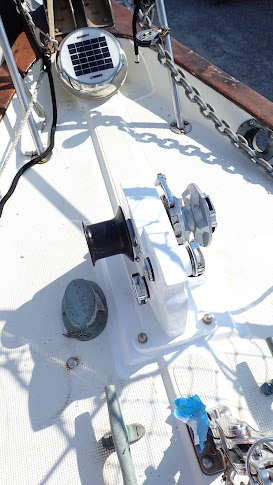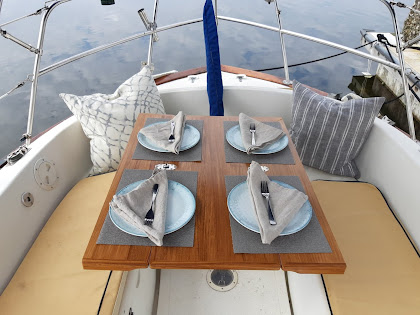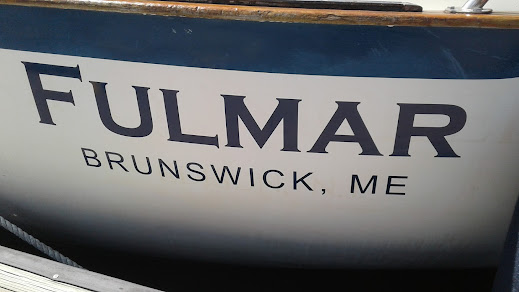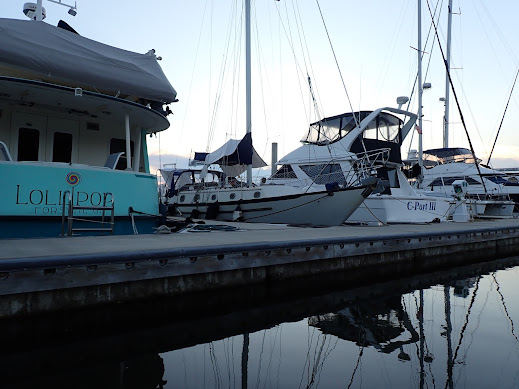- Model: 1982 Pacific Seacraft 37 (AKA Crealock 37)
- Length Overall: 36' 11"
- Draft: 5’ 10” (1.6 m) designed draft (actual draft for the 40-year-old Fulmar, fully loaded for cruising is closer to 6’ or 1.8 m)
- Displacement: 16,200 lb (7,257 kg)
- Ballast: 6,200 lb (2,722 kg), external lead keel
- Rig: Cutter (1 mast, 3 sails: mainsail, genoa/yankee, staysail)
- Mast Height: 47'
- Sail Area: 621 sq. ft.
- Engine: 38 hp Beta diesel (28.3 kw)
- Solar power generation capacity: 640 watts
We purchased Fulmar in 2015 in New Jersey from her previous owners, Chuck and Dianne Burke. They owned the boat (then called Nifty Nickers) for about 20 years and cruised her full-time for about a decade. As Dianne said to us recently, “Fulmar knows her way from Maine to the Bahamas. She’ll keep you safe.”
Fulmar was in Hurricane Sandy in 2012. Chuck and Dianne did everything right to keep the boat safe. They had it hauled out at a boatyard for the storm. But the storm surge was so high that the boat yard flooded and another boat that had been left in the water broke free, floated into the boat yard, and crashed into a line of boats on their jackstands. The entire line of boats toppled over like dominoes. Fulmar was the only one that didn’t suffer major damage. Her solar panels, radar, and rudder were damaged but the hull basically didn’t have a scratch on it. The Pacific Seacraft plant built a new rudder, which was an exact replacement of the original (the advantage of having a boat that is still in production). The fact that she escaped that ordeal unscathed gives us great confidence in Fulmar’s strength.
 |
| Reinstalling the rudder after doing some work on the skeg. |
This is what we really like about Fulmar:
Sails Great. Fulmar moves easily in light air and is a freight train when the wind pipes up. Thanks to her long keel and full skeg, she tracks well when surfing down waves. Her narrow beam, high displacement, and deep, v-shaped bottom make her relatively comfortable when beating upwind into big seas.
Modest Size. Her modest size means that she can be singlehanded easily, which is an important feature. It also means that she maneuvers pretty easily in tight quarters, which is nice when docking at an unfamiliar marina. With a mast height of only 47’ (~50’ including instruments), we can easily travel the entire Atlantic Intracoastal Waterway and not worry about bridge heights. The cost of ownership increases exponentially with the size of the boat. Smaller is cheaper.
 |
| Our brand new Sea Tiger manual windlass. It's an exact replacement of the original Sea Tiger that was on the boat for almost 40 years. |
 |
| When we are using the cockpit we fold the tiller out of the way. |
 |
| Sometimes Damon yells at the engine from inside its cave. |
Here are the things that we often wish were different:
 |
| Seriously where are we gonna put everything? |
The layout. Fulmar’s layout is virtually identical to thousands of boat designs developed over the past century and a half. The issue we have is that this layout is optimized for relatively large crews who spend short amounts of time living aboard, not for a couple of people living aboard full-time. Why do we need bunk space to sleep six people? The problem this creates is that there is relatively little storage space and no separation between the “work” parts of the boat and the “living” parts of the boat.
 |
| Does anyone actually use their quarter berth as a berth? |




No comments:
Post a Comment